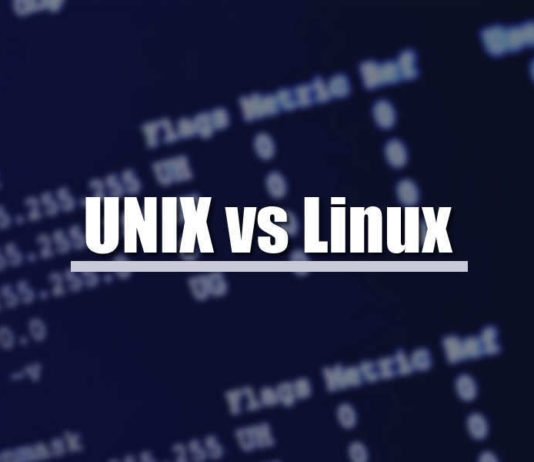Before the creation of Linux, and before the rise of Windows, the computing world was dominated by Unix. And actually, Linux is a UNIX Clone. In this article, UNIX vs Linux you will find out how UNIX differs from Linux.
UNIX was first developed by AT&T in 1969. UNIX became the first portable operating system, almost the entire operating system is written in the C programming language that allowed Unix to reach numerous platforms. After many years of evolution, we don’t have the Unix anymore.
Most of today’s variants of UNIX are licensed versions of the technology. Today’s Oracle Solaris, for example, began life as Sun Solaris until Oracle took over the company in 2010. Solaris was originally designed by Sun Microsystems to incorporate a wide array of tools and environments in order to allow its customers to get the best out of its own workstation and server hardware.
Hewlett Packard and IBM created their own flavors of UNIX too, in the respective form of HP-UX and AIX. In case you didn’t know, Mac OS X is also a certified Unix operating system.
And about Linux, developed by Linus Torvalds in 1991. Linux is basically the name of the Kernel. The graphical user interface and the applications make it a complete operating system. The main difference in UNIX vs Linux, performance will be dominated by Linux. And at least 65% of applications running on proprietary versions of UNIX in 2012 will have migrated to Linux by 2017.
Contents
UNIX vs Linux:
Simple Explanation
Unix is an operating system that is very popular in universities, companies, big enterprises, etc.
Linux is an example of Open Source software development and Free Operating System (OS)
Development and Distribution
Unix systems are divided into various other flavors, mostly developed by AT&T as well as various commercial vendors and non-profit organizations.
Linux is developed by Open Source development i.e. through sharing and collaboration of code and features through forums etc and it is distributed by various vendors.
Users
Unix operating systems were developed mainly for mainframes, servers, and workstations except for OSX, which is designed for everyone. The Unix environment and the client-server program model were essential elements in the development of the Internet
Whereas Linux is for everyone. From home users to developers and computer enthusiasts alike.
Usage
The UNIX operating system is used in internet servers, workstations & PCs. The backbone of the majority of financial infrastructure and many 24×365 high availability solutions.
Linux can be installed on a wide variety of computer hardware, ranging from mobile phones, tablet computers, and video game consoles, to mainframes and supercomputers.
File System Support
The file systems supported by UNIX are jfs, gpfs, hfs, hfs+, ufs, xfs, zfs format.
And in case of Linux, the supported file systems are Ext2, Ext3, Ext4, Jfs, ReiserFS, Xfs, Btrfs, FAT, FAT32, NTFS
Text Mode Interface
Originally the Bourne Shell is UNIX text mode interface. Now it’s compatible with many others including BASH, Korn & C.
BASH (Bourne Again SHell) is the Linux default shell. It can support multiple command interpreters.
GUI
Initially Unix was a command based OS, but later a GUI was created called Common Desktop Environment. Most distributions now ship with Gnome.
Linux typically provides two GUIs, KDE and Gnome. But there are millions of alternatives such as LXDE, Xfce, Unity, Mate, twm, ect.
Security
A rough estimate of UNIX viruses is between 85 -120 viruses reported to date.
Linux has had about 60-100 viruses listed till date. None of them actively spreading nowadays.
Threat Detection And Solution
Because of the proprietary nature of the original Unix, users have to wait for a while, to get the proper bug fixing patch. But these are not as common.
In case of Linux, threat detection and solution is very fast, as Linux is mainly community-driven and whenever any Linux user posts any kind of threat, several developers start working on it from different parts of the world.
Processors
Unix can be run only on specific CPU processors such as x86/x64, Sparc, Power, Itanium, PA-RISC, PowerPC, and many others.
Linux does not require special hardware for it to run. So it supports dozens of different kinds of processors.
Cost
As Linux is freely available it has a cost advantage against UNIX, which due to the need to purchase licenses can limit the user numbers. This is also a result of it coming with different cost structures according to different vendors. So Linux can be cheaper, more accessible and offer an improved opportunity to generate a return on investment (ROI) for your organization.
Linux implementation will outstrip the UNIX equivalent and do it at a vastly reduced cost point. Hardware is more expensive on UNIX and you can’t use public Cloud like you can on Linux.
Popular Ones
Different versions of Unix are as follows: OS X, Solaris, HP-UX, AIX, Inspur, HP-UX, z/OS, Irix, Unixware, DNCP and SCO OpenServer.
There are comparatively more distributions or versions of Linux operating systems. The distributions available for Linux are as follows: Redhat, Slackware, Debian, Solaris, Ubuntu, CentOS, Fedora.


